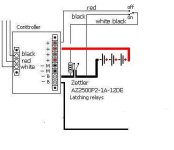An oscilloscope is purely a voltage measuring tool, if you wish to measure amps, I would go with a dedicated ammeter. A good multimeter will do it, but they generally cant handle more than an amp or so.
There is no real need to measure the current through your resistor, so long as you know the actual resistance of your resistor, as well as the voltage of the pack its quite easy.
amps = Volts / Resistance 72V/100ohm = 0.72 amps (If your voltage is really this high, I would go with a larger power resistor, or a larger value resistor, as this is over 51W going through that resistor.)
So long as your are not in super-conducting levels this equations is for all intents and purpose's correct.
As a bit of a warning to anyone thinking of forgoing a pre-charge circuit, if your controller calls for one, please listen to it.
The issue is not the sparking that occurs when you connect your battery to your controller, it is the electrolytic capacitors inside your controller.
They do not like to be charged too quickly.
Our pre-charge circuit broke while it was being shipped. (One of the resistor leads tore out)
So, our controller was getting charged for all intents and purposes instantly. (Charging at dead short current ~10,000 Amps)
The first thing that happened was our contactors welded closed. (They were rated for 650 amp break current)
We managed to discover/fix our broken pre-charge circuit and welded contactors before anyone got hurt.
But the damage had already been done, and our controller decided it didn't want to live anymore, and shot a three foot flame out the side.
The black stuff on the snowmobile is mostly the type D extinguisher that I used, since when I first saw the flame I thought our li-po pack was going nuclear.
If you look, there were originally Two bus bars inside the controller.
This is the bottom plate of the controller, Note the arc welded hole in it, and the whole plate had a nice U shape to it.
I highly doubt any e-bike controller would let the magic smoke out as fast as ours did, but slamming your capacitors will reduce their life, and possibly let some of the magic smoke out.
I would also recommend putting a current limiting device on your controller if you are starting to push the amps, as that would have prevented the massive charging spikes that welded our contractors, and damaged the capacitors.
(we did actually fix it after this and finished competed in the rest of the events.)
(I'm going to do a full accounting with video, and more pictures of the adventure as soon as I get time to get them all together)





